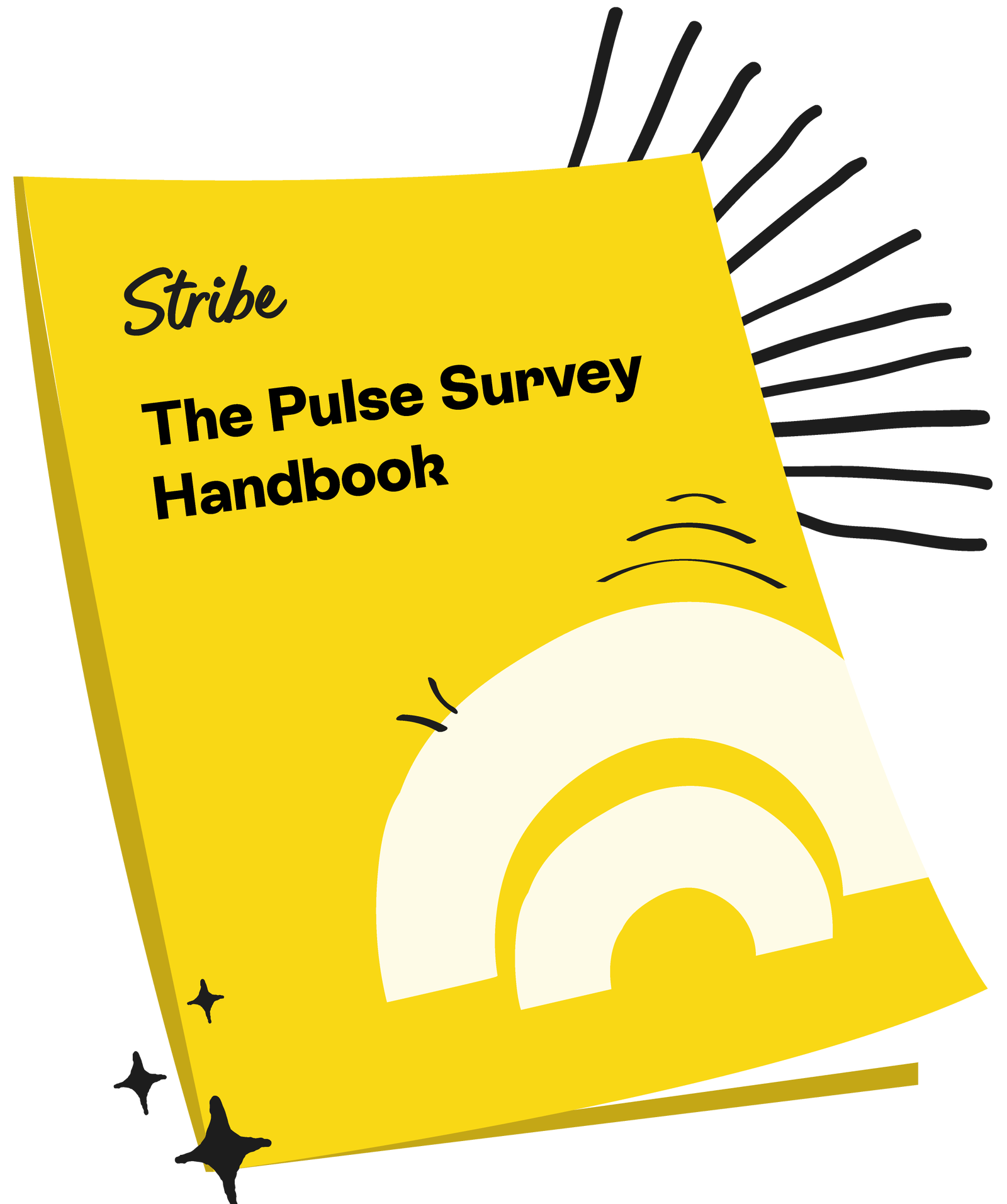7 employee engagement metrics to track that prove impact
Go deeper than surface-level satisfaction scores. Employee engagement metrics to track if you want your engagement efforts to get results.
Read MoreIf you’ve never been introduced to Stribe – hello and welcome!
We’re an employee engagement platform with the mission of creating happier and healthier teams – and employee pulse surveys are kind of our whole thing.
And it just so happens that you’ve just stumble upon our most downloaded resource ever – The Pulse Survey Handbook including 70+ of the best employee pulse survey questions to ask your team.
It’s the only pulse survey guide you’ll need, covering everything from pulse survey strategies, to survey scheduling, and how to craft the best pulse survey questions to improve engagement fast.
With it, we hope to give you the knowledge and confidence to start using surveys within your workplaces.
Enjoy!

Employee pulse surveys are short surveys that are sent to staff regularly and periodically.
Depending on the size and structure of the organisation this might be weekly, fortnightly, monthly, or quarterly.
Pulse surveys act as regular check-ins with employees so feedback can be measured (and acted upon) more frequently – unlike annual surveys which take more time and effort to curate and analyse.
Pulse surveys are great for organisations that want to keep their finger on the pulse of employee feelings, and take an employee-led approach to their mental health, wellbeing, or employee engagement strategies.
Pulse surveys should quick to complete, and no more than 5 – 10 questions long.
Depending on the size and structure of your organisation – and what you’re trying to achieve – pulse surveys can be sent weekly, fortnightly, monthly, or quarterly.
But what we’ve found works best is that your pulse survey frequency should be in line with how quickly you can communicate the results and create change based on employees’ feedback.
Stribe data shows that the best time to send surveys are:
– Mondays 10:00am – 11:00am
– Thursdays 10:00am – 11:00am
– Fridays 2:00pm – 3:00pm
Stribe’s pulse survey software standard pricing is £3.00 per employee, per month.
This includes complete access to the platform, all features, and full support from our team.
Discounts are available for charities, and for organisations with 100+ employees.
Pulse surveys are a great way to check-in with employees regularly to understand how they’re feeling, so you can quickly spot and tackle issues that are affecting them.
As you can imagine, when you approach feedback this way, it creates a workplace where people feel heard and valued – which comes with a variety of organisational benefits.
Employees who are more engaged have higher levels of creativity and productivity and are more likely to achieve their targets – this all contributes towards higher profitability.
Work-related stress accounts for an estimated 13.7 million lost workdays every year. Happier and more engaged employees are less likely to take sick leave. Using employee pulse surveys will help you understand and address issues that are affecting your employees, ultimately improving your employee engagement.
When employees are happy at work it creates an enhanced experience for everyone. In the long run, this creates an improvement in your employee brand and the way potential employees view your workplace.
The higher your employee engagement, the lower your staff turnover will be. This is because employees are enjoying their work, feel happy within their team, and are bought into your organisation’s mission. This has a direct impact on your organisation’s productivity and profitability because you are spending less time onboarding teammates and getting them up to speed!

Planning is the key to success with pulse surveys – and we don’t just mean the questions.
Whether you’ve run none or 100 pulse surveys, it’s always good to take a step back and look at how you’re launching them to your employees.
Having an owner will guarantee that your pulse survey moves from an idea to completion. The owner needs to have an interest in employee surveys, knowledgeable with internal communications, be able to manage key stakeholders, and have the power to make changes based on the pulse survey feedback.
Ensure your employee communication systems are up to scratch so that you can close the feedback loop with your employees when the pulse survey ends.
Creating a pulse survey plan that defines who, what, when, where and how will help guide your efforts. At Stribe we work with our customers to create launch plans that guarantee their pulse survey campaigns are launched without a hitch.
Start small, and plan for every answer so that you know you can create change based on the feedback from your employees. If employees don’t see change based on their answers survey engagement rates will suffer.
How you introduce your pulse survey will have a strong impact on the response rate. Shape your messaging to align with your employees’ needs. Think about the internal communication channels you need to use e.g. company-wide email, stand-ups, Slack, and line-management networks. Focus on communicating how employee responses will shape company goals and bring managers on-board to boost response rates from their teams.
As soon as you have an owner, you know how you’ll close the feedback loop, and you have a communication plan agreed you’re ready to send your pulse campaign.
Once your survey has finished, bring key stakeholders together to discuss the results and the actions your organisation needs to take as a result. Create a plan of action based on the discussion.
Employees will want to know what changes you’re making based on their feedback. Sharing the full pulse results and what action you’re taking will help them feel heard. Encourage employees to give feedback on your communications so that you can learn how to make the process more effective for them in the future.

There’s a science to structuring and sending pulse survey questions.
If you don’t spend time thinking about the way your questions are crafted, you risk creating more questions than answers when you try to analyse your survey results.
We all tend to respond positively to questions if the tone makes it sound like we should.
Think about whether you would like respondent’s answers to be reflective or in the moment. The structure of the question will give you different insights.
Use questions broad enough to apply to everyone that the survey was sent to.
Make sure you use a mixture of open and closed questions to gather detailed insights that help you build an action plan.
Focus on questions that create easily measured answers so that you can gain clarity from your survey results.
One of the biggest frustrations for employees who take the time to give thoughtful feedback is feeling like their comments are ignored.
Asking the right questions and gaining good response rates in your pulse survey are only the first steps in the journey.
The most important part of your pulse surveys is developing an action plan and communicating the results so that employees can see that you are listening and acting on their feedback.
Here are the steps we recommend:
Now that you’re filled in on what pulse surveys are, and the different ways you can use them with your team, we’ve put together some pulse survey examples that you might want to use in your next employee pulse survey.
For more examples, download the Pulse Survey Handbook which comes with 70+ employee pulse survey questions.
Want to learn more about Stribe? We’d love to show you.
About the author

Lucy Harvey, COO at Stribe, has 11+ years’ experience in purpose-driven leadership roles across health, wellbeing, internal communications, employee engagement, and marketing. She is passionate about creating workplaces where people are happy, fulfilled, and feel comfortable and safe to talk.
Go deeper than surface-level satisfaction scores. Employee engagement metrics to track if you want your engagement efforts to get results.
Read MoreSoftware gives you the tools to run surveys yourself. A consultancy does it for you. Both can be helpful, but which one works best depends on your goals!
Read MoreHow to run your first employee survey. Tips from Stribe COO Lucy Harvey, who has helped hundreds of UK organisations launch their first ever survey.
Read More